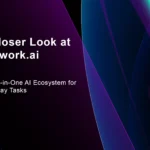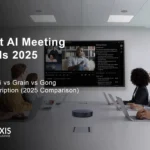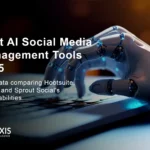Artificial intelligence has transformed how we learn and teach — from adaptive quizzes and personalized feedback to smart dashboards for educators. Yet, most AI pilots never make it into production. Deloitte reports that nearly 80% of PoCs fail, often because teams underestimate what it takes to scale AI responsibly. Building sustainable AI is more than model training. It’s about creating reliable, compliant, and continuously improving systems that deliver measurable learning outcomes and business value.
How Selleo Can Help You Move from AI Concept to Scalable Success
- Turn your PoC into a real product. We transform AI prototypes into production-ready platforms — faster, safer, and with measurable ROI.
- Build trust through compliance. Notre ISO 27001 and 22301 certifications ensure your solution meets FERPA, GDPR, and enterprise-level security standards.
- Design for scalability, not just success. Selleo engineers create AI architectures that grow with your product — from MVP to global deployment.
- Get expert guidance from day one. Through AI Discovery Workshops, we help you validate data, align goals, and map a clear path to production.
Why Most AI Proof-of-Concepts Fail — and What EdTech Can Learn
In education, an AI proof of concept might work flawlessly in a sandbox but fall apart once exposed to real-world learners. Common causes include weak data governance, missing ownership, and underestimated maintenance. The problem deepens with regulatory pressure — FERPA, GDPR — and fragmented learning data spread across LMS platforms and tools.
A chatbot that helps students summarize lessons can suddenly break when the dataset changes format or when privacy rules restrict its access. That’s why AI readiness in education means preparing early: define KPIs, ensure data quality, and plan for monitoring before the first line of code.

Even failed pilots aren’t wasted effort. Every PoC reveals a missing process — from compliance gaps to workflow friction. When those lessons are captured, the organization evolves. That’s how companies like Selleo – Your Web & Mobile Software Development Partner turn experimentation into maturity, combining technical depth with ISO-certified security and agile delivery.
Turning a Failed PoC into a Strategic Asset
At Selleo, we’ve seen many clients arrive with promising but “stuck” prototypes. The first step isn’t to start over — it’s to document what worked and what didn’t. We analyze data pipelines, model behavior, and feedback loops to identify the reusable parts.
For instance, in our Exegov AI platform, what started as an experiment with OpenAI evolved into a production-ready system. Initially, the team wanted to generate business plans and OKRs interactively through chat. Early PoCs faced challenges with prompt handling, model accuracy, and integration. Instead of scrapping them, we refined the architecture, implemented structured JSON outputs, and built robust data validation.
The result? A live platform that helps businesses plan strategy through conversational AI — complete with authentication, a Kanban task board, and role-based access. By treating early iterations as learning assets, the project moved from prototype to product in record time.
This mindset — turning “failed” PoCs into structured insight — underpins Selleo’s entire AI enablement approach.
From Pilot to Production — Building Scalable and Compliant AI
Scaling AI responsibly requires structure, not just speed. Sustainable systems rest on three pillars: data pipelines, MLOps, and governance.
At Selleo, every project starts with Discovery Workshops — aligning goals like engagement or personalization with measurable outcomes. From there, we design the architecture to ensure reliability, security, and compliance from day one.
In Exegov’s case, integrating OpenAI required strong governance. We implemented compliance by design — encrypted data handling, anonymization layers, and ISO 27001–aligned practices. This ensured AI responses remained secure and auditable, even when generating dynamic content.
Avoiding over-engineering is also key. Small, explainable models often outperform black-box systems in education. They’re easier to maintain, retrain, and explain to regulators or educators. Tools like MLflow and TensorFlow Extended support model versioning and transparency, enabling teams to trace every change across iterations.

To see how this works in practice, explore the artificial intelligence solutions from Selleo — an end-to-end framework combining design, engineering, and DevOps for scalable, compliant AI.
Measuring Success — ROI and Sustainability of AI in Education
AI in EdTech must prove its worth through real metrics — not just innovation headlines. ROI isn’t only financial; it’s educational and operational. Reduced time-to-content, better retention, and improved learner engagement all signal real value.
Selleo’s projects show this clearly:
- Qstream achieved 90%+ engagement through microlearning powered by adaptive AI.
- CoachApp accelerated L&D content creation by 20× using multi-agent AI architecture.
- Exegov transformed business planning into a guided, AI-driven process that saves users hours of manual work.
These outcomes prove that sustainable AI is measurable — not theoretical. When coupled with continuous monitoring (bias detection, retraining cycles, ethical oversight), AI evolves as a living ecosystem that learns with its users.





